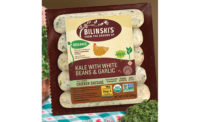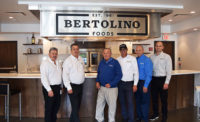A tasty new use for cattle hides

The meat snack category has continued to expand, not only with new flavors but also with new formats. One of the latest evolutions has introduced a new competitor to the traditional pork rind. Holy Snacks has introduced Holy Cow, a line of beef rinds that finds a new use for a commodity that would normally go to waste.
“The correct term for it is upcycling – [we’re] taking waste and turning it into a snack,” says Javon Bangs, co-founder of Holy Snacks. “Beef consumption in the U.S. is the highest it’s been in a decade, but as the demand for leather is plummeting for various reasons, mostly because to cheaper synthetic alternatives, 100-pound cowhides are piling up all over the country. They were once destined for leather tanners, and now the farmers can’t find buyers for them, so they either bury them or ship them off to the landfill.”
Bangs and co-founder Nick Wong both grew up in rural communities – Bangs in Washington state and Wong in California. The idea came after Wong came back from a trip to Indonesia, where beef skin is regularly consumed.
“When he came back and told me about this, it piqued my interest,” Bangs explains. When he asked his local farmer what happened to his beef hides, he said they were either sold for pennies on the dollar, buried on the farm, or sent to a landfill.
“We wanted to spearhead this mission against waste, and we thought that if it’s a viable option in Indonesia, then we can introduce it in the Western world,” he adds.
Processing the beef skin into beef rinds was a difficult process – you can’t make a beef rind the way you do a pork rind – but Holy Cow snacks are now available through batch orders on the company’s website, www.holycow.eco, in several different flavors. Consumers add their name to a waiting list, and they are notified when a batch is available for ordering.
“We spent countless hours trying to perfect the recipe and ensure that we’re not just on par with pork rinds. We need to be a standalone option that people choose over pork rinds,” Bangs notes. “You’d be surprised how tasty the rind is compared to a pork rind. I associated beef skin with something that was rough and big. The way we were able to develop the rind, it’s very fluffy, has great texture and falls apart. We’ve converted lots of people.”
The rinds are produced in Seattle, using beef hides from local producers. Bangs points out that the Northwest agriculture community has been hit particularly hard in recent years, and there has been a year-over-year increase in farm bankruptcies of 109 percent. The company sources its raw materials from farmers who have declared bankruptcy.
“We thought to start our focus here, help these farms generate new revenue so maybe they can gain a little bit of economic independence back,” he says.

Looking for a reprint of this article?
From high-res PDFs to custom plaques, order your copy today!






